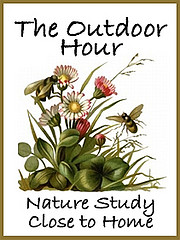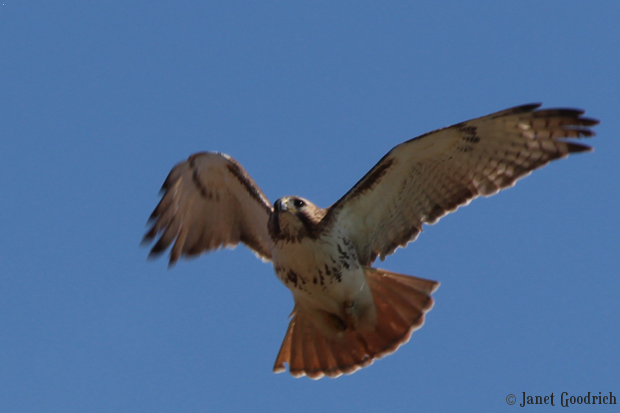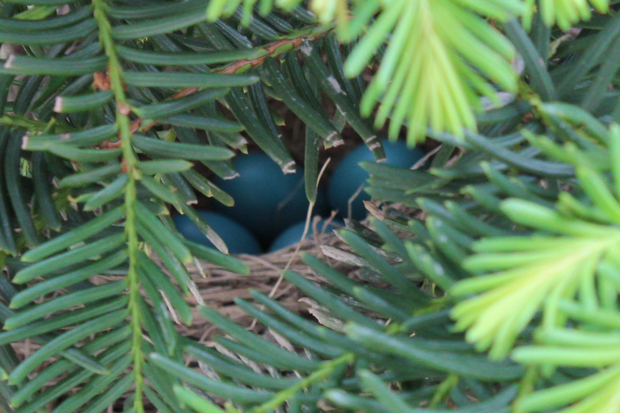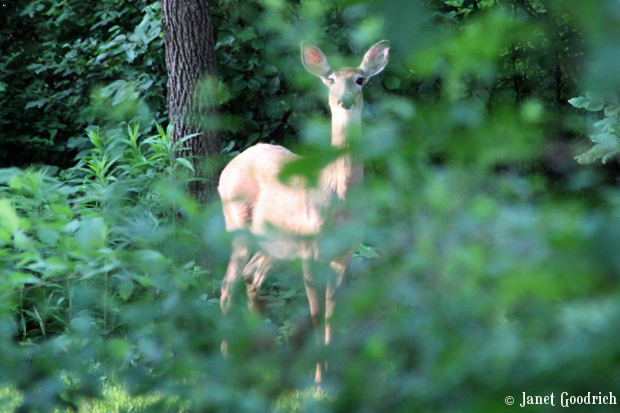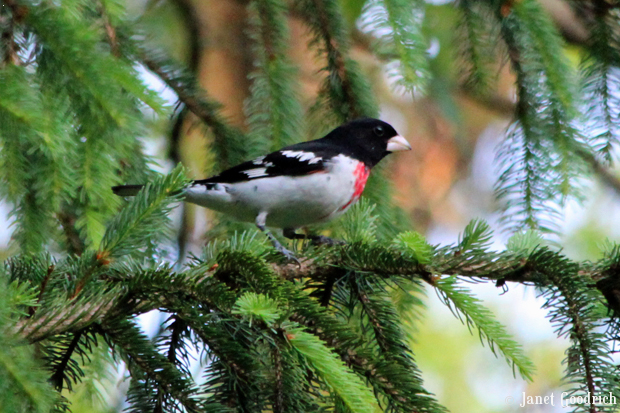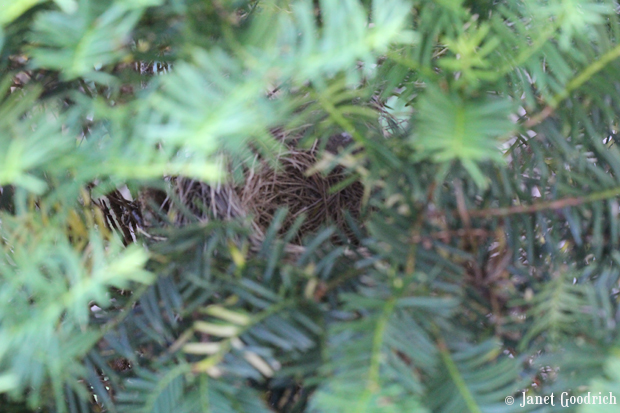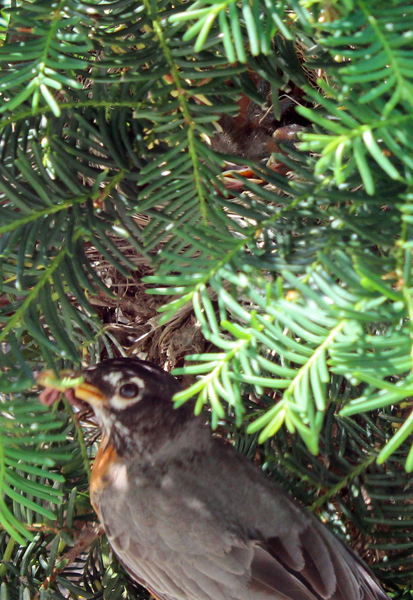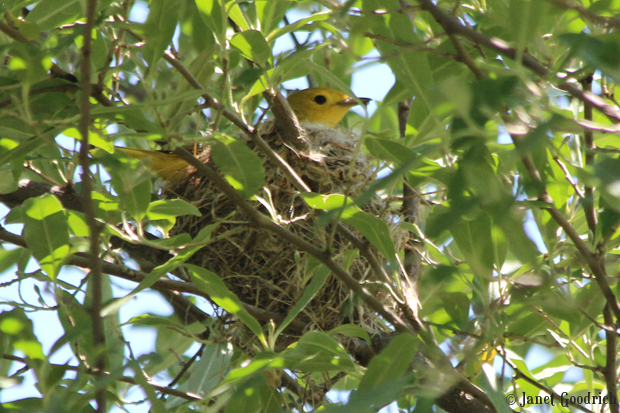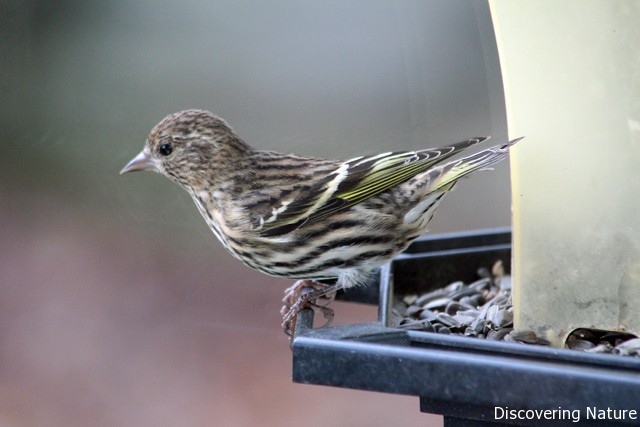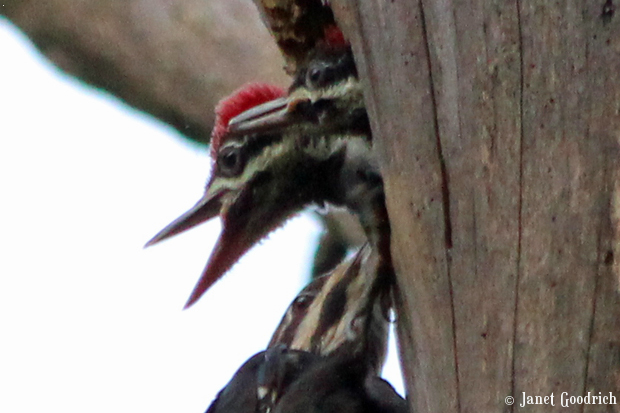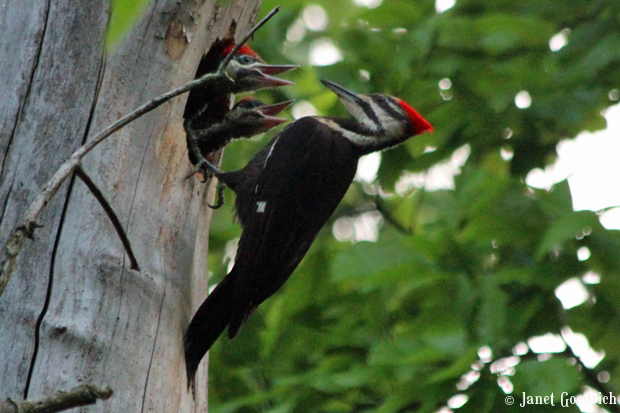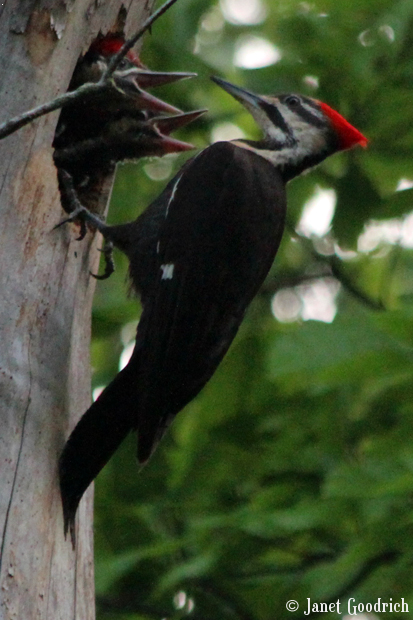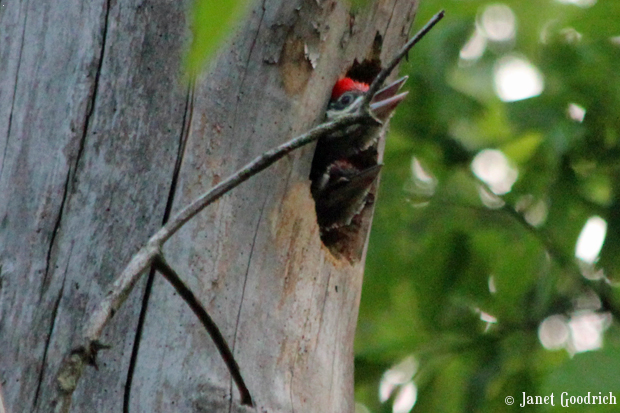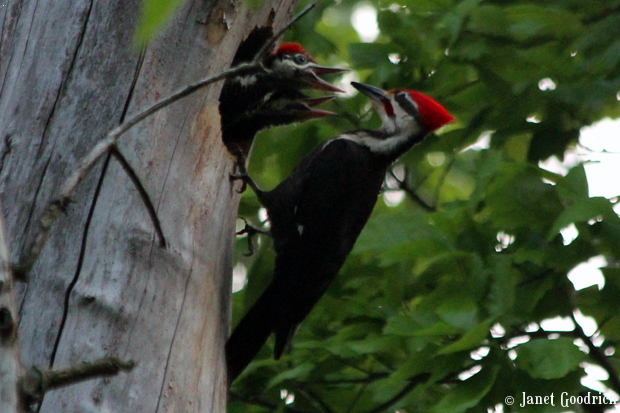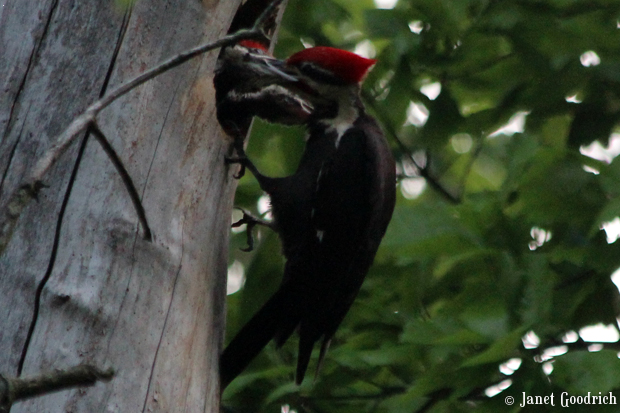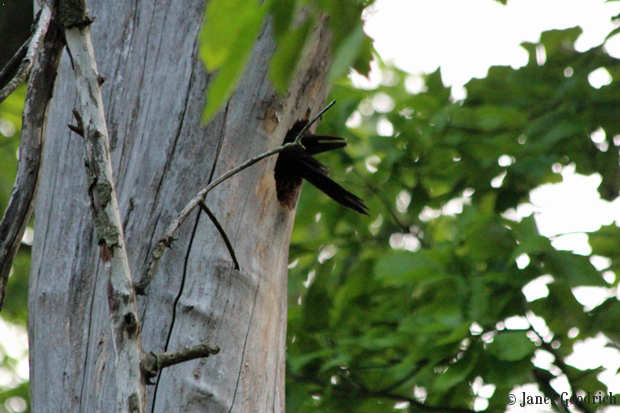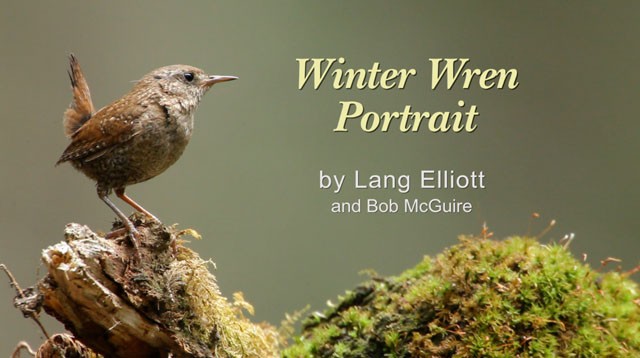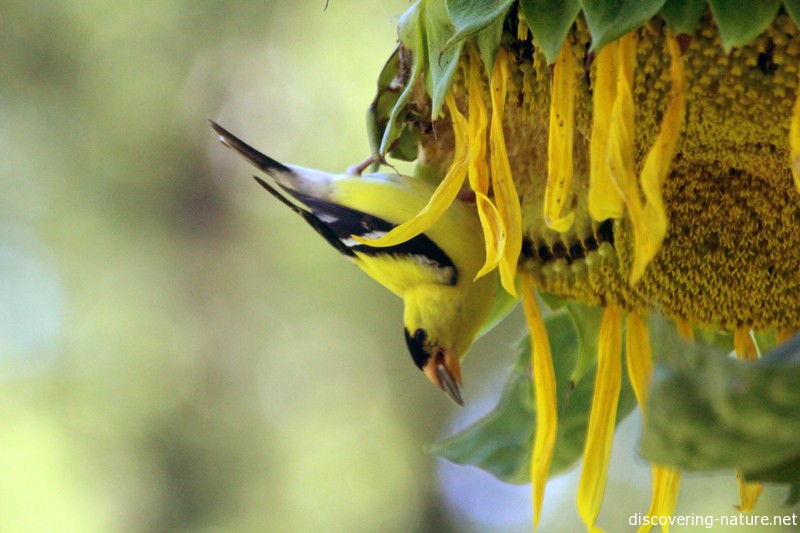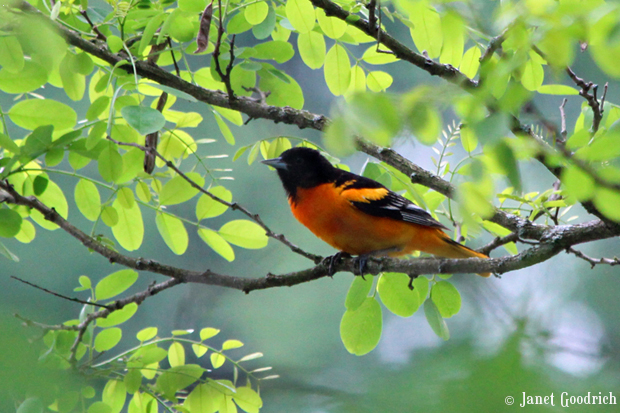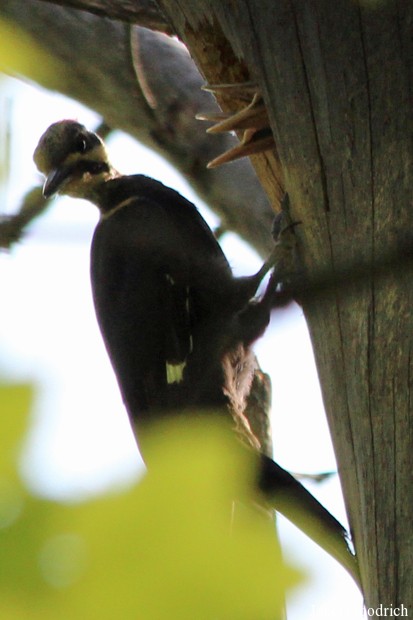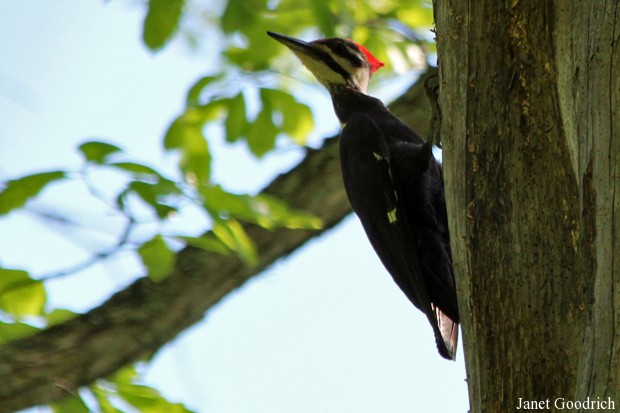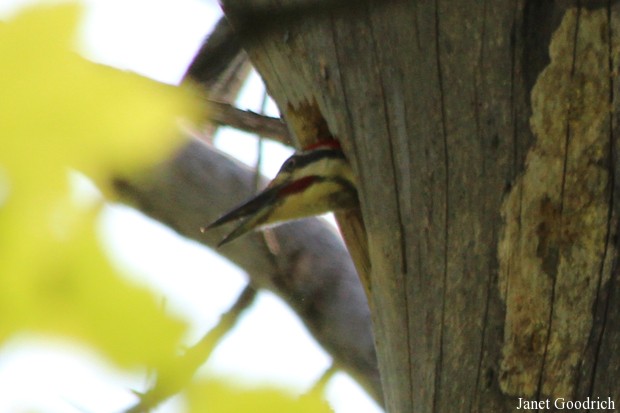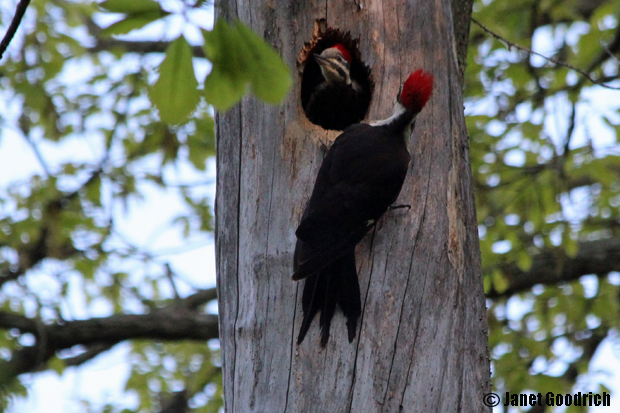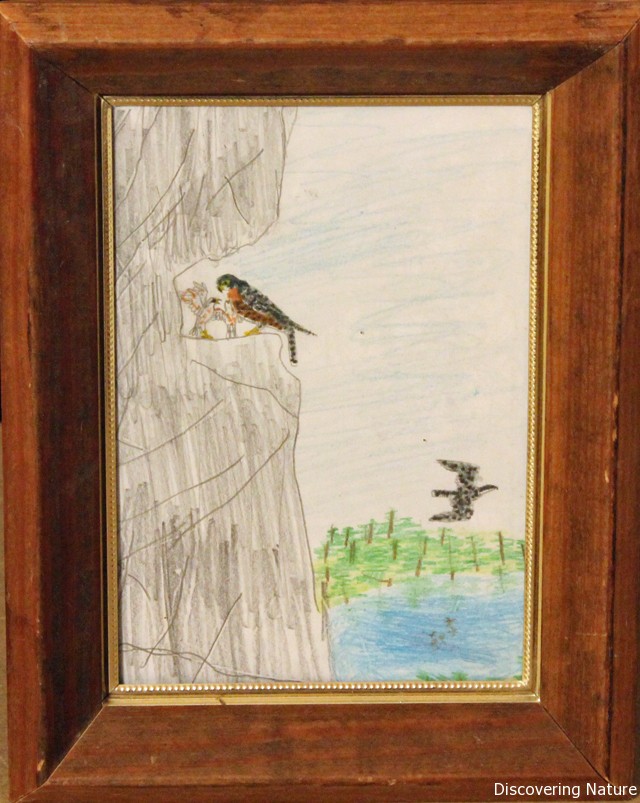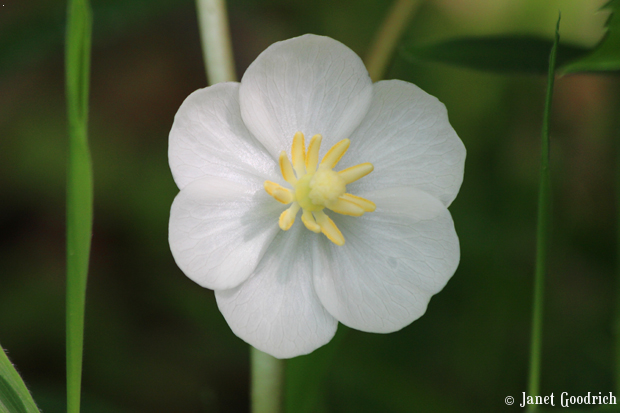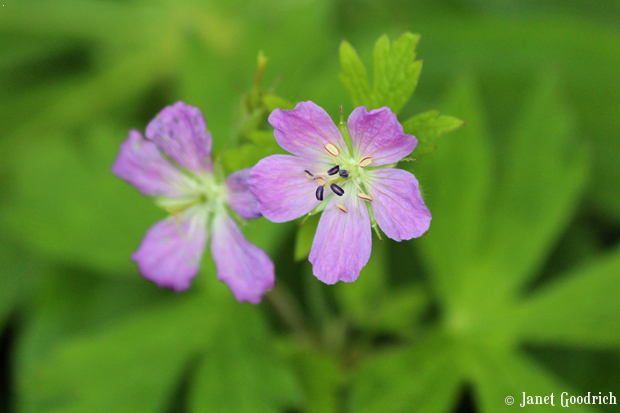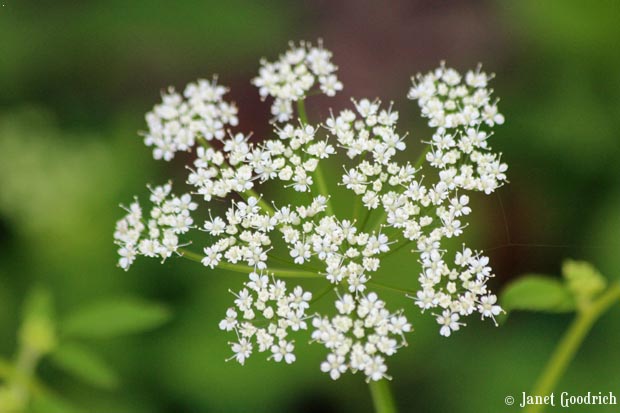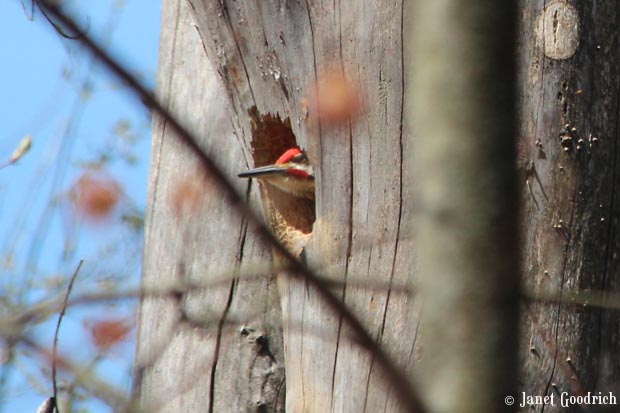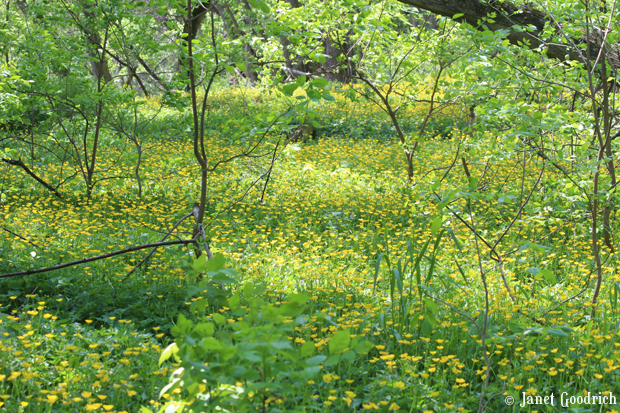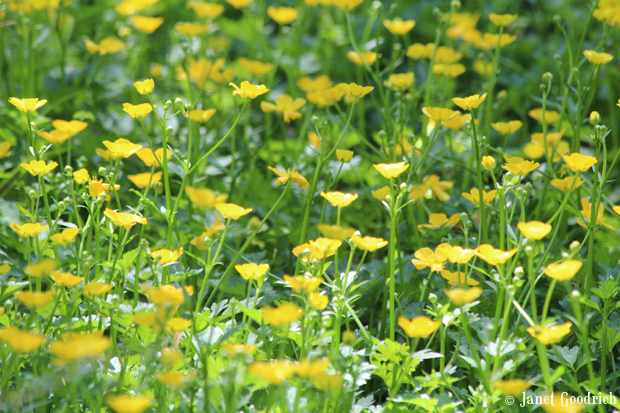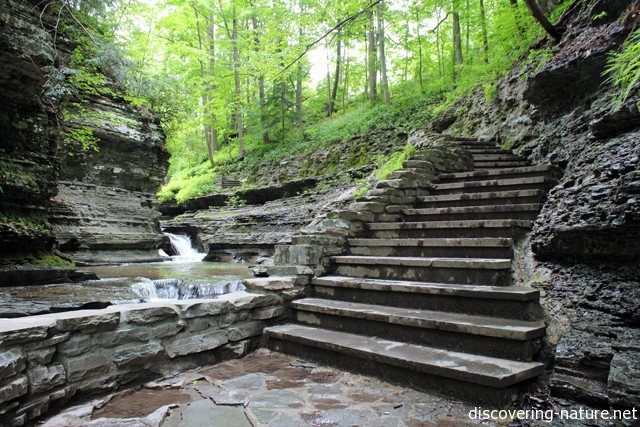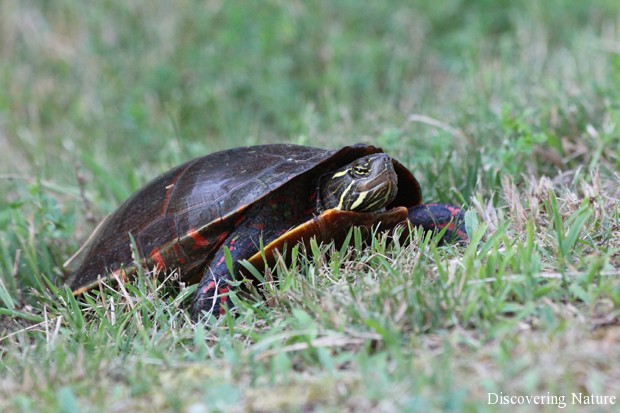-
Outdoor Hour Challenge: Pileated Woodpeckers
Back in mid-April, my daughters and I stumbled upon a pileated woodpecker nest on one of our walks in the woods. We noticed not one, but two adult birds on a dead tree. The female flew away; the male went inside.
When we went past the spot in subsequent weeks, it seemed like nothing was going on there. But more recently it has become apparent that it was — and is — an active nest after all.
This is the female woodpecker, nearly as large as a crow, preparing to feed. The youngsters are a male (with the red sideburns), and a female (with black sideburns).
The male adult has more red overall — a red crest that reaches all the way down his forehead, and red sideburns.
 I’ve posted some pictures of feeding here, and of a nest exchange here.
I’ve posted some pictures of feeding here, and of a nest exchange here.The girls and I compiled a list of the most interesting things we’ve learned about pileateds:
- Their tongues coil all the way around their skulls and are long, sharp spears with backward-facing barbs that can be extended and retracted.
- Zygodactylus feet — two toes face forward, two face backward. (A fun new word to pull out from time to time!)
- The nestlings’ solid waste is in small packets that the parent birds carry away. (I witnessed this one morning after a feeding.)
- They are “forest engineers,” excavating cavities that other birds and mammals use for their homes.
- Their call sounds like the wilderness. One of their nicknames among the early settlers was “the laughing woodpecker,” and they do have an wild-sounding laugh — it makes me think of Bertha Rochester in the attic (Jane Eyre).
- A normal clutch is four eggs.
- The parents feed by regurgitating from their crops directly into the eager beaks of their young.
- The male ends up doing the majority of the incubating.
- They have sleeping cavities in trees, and often these holes have escape routes.
- One of their main foods is carpenter ants.
Though my reflex is to think of them as wilderness birds, they have adapted quite well to human “landscape engineering.” I know of three pairs nearby, so I guess this provides some anecdotal evidence. They’re often compared to ivory-billed woodpeckers, which have fared very differently and are now, probably, extinct.
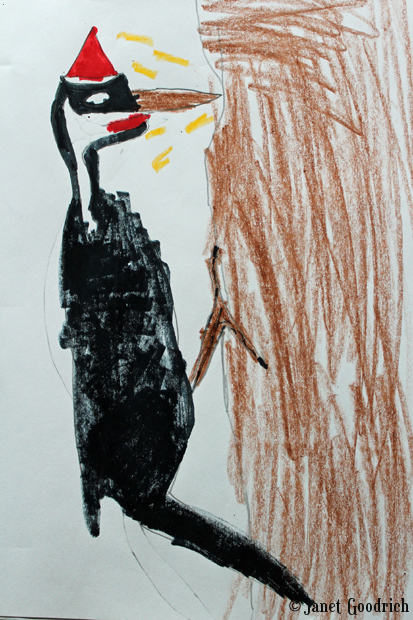
8-year-old's drawing 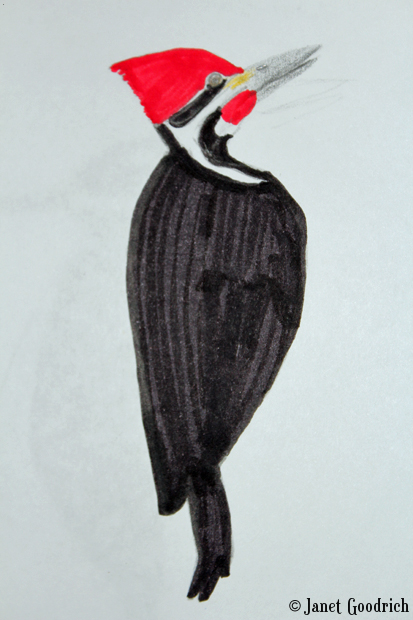
11-year-old's drawing Our favorite resources, in addition to observation, have been this website and several books, of which this one has been the most complete.
I remember hearing a pileated woodpecker while riding my bike a year ago, and working hard to get my first picture of one. It was far away and a little blurry, but I was completely thrilled. I never would have guessed the sights we had in store for us this year. If the trees had been fully leafed-out, we probably wouldn’t have seen this pair that day in April. And though the young make quite a racket begging for food when their parents are near, we might chalk the strange sound up to something else if we didn’t know the source. It’s been a good reminder for us to keep an open mind and alert senses in the woods.
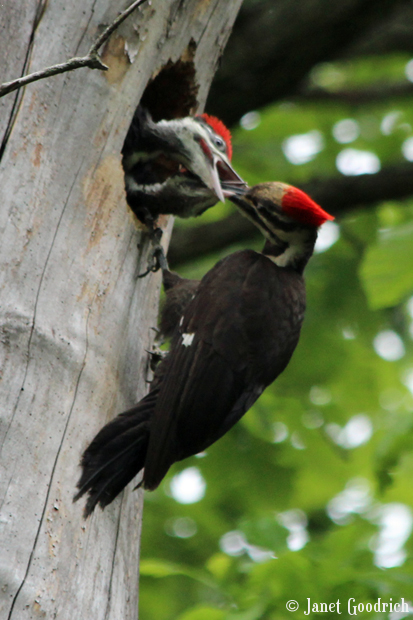
Feeding can be a hazardous occupation... I’m submitting this post to the Outdoor Hour Challenge, a great round-up of nature-study postings each month.
-
Back yard peace, front yard violence
A few mornings ago, I sat in the back yard and enjoyed sights like these.
The rose-breasted grosbeak has a habit of singing quietly while he eats at the feeder. There were lots of other birds, and the continual scratch of squirrel claws on bark as the gray squirrels chased one another among the walnut branches. As a purely aesthetic experience, everything seemed very peaceful.
But out front, it was a different story, more revelatory of the underlying peril in all things natural. When I went inside, my youngest greeted me seriously with the announcement that she’d heard “two kerfuffles” involving wing-flapping just outside. When we went to the window to look at the robin’s nest in the shrub just beneath, there was only one nestling left.
By the end of the day, it looked, like this.
Previously it had looked, through the window, like this.
And then like this.
Crows robbed the nest.
I’m reading a book by a wildlife rehabilitator, and in one scene a Cooper’s hawk nabs a newly-released young blue jay she had raised from a nestling. It’s devastating, yet she can’t blame the hawk for needing to eat. “Whose side are you on?” her husband asks her.
“I’m on everyone’s side,” she replies.
I wish I could be that magnanimous. I know crows are incredibly smart. I respect them and respect their need to eat and recognize the irrelevance to them of the human moral code. But anyone who has ever seen nestlings holds that sight in mind as the archetype of utter defenselessness and fragility. They were a week old.
We took the nest out of the bush just in case the robins might try a second clutch in the same location. It’s not a good spot — too exposed. We feared that from the start, and had been careful not to go near the nest or otherwise draw attention to it. Predators are the most attentive nature observers.
It’s also more of a front-row seat than I want to have again any time soon.
The life of the birds, especially of our migratory songbirds, is a series of adventures and of hairbreadth escapes by flood and field. Very few of them probably die a natural death, or even live out half their appointed days… They lead the darkest kind of pioneer life, even in our gardens and orchards, and under the walls of our houses. Not a day or a night passes, from the time the eggs are laid till the young are flown, when the chances are not greatly in favor of the nest being rifled and its contents devoured — by owls, skunks, minks, and coons at night, and by crows, jays, squirrels, weasels, snakes, and rats during the day. Infancy, we say, is hedged about by many perils; but the infancy of birds is cradled and pillowed in peril. (John Burroughs, “The Tragedies of the Nests”)
-
Pileated Woodpecker Feeding
I watched the pileated woodpeckers feeding their young yesterday morning. The sun was just peeking over the horizon, and I was still rustling around in dry leaves trying to find a good spot to settle, when the female showed up.
The youngsters made an incredible racket declaring their ravenous appetites, sounding like a combination of rasping hinge and buzzing insect. When she left, they continued calling for food.
The male came next, regurgitating directly into their beaks with his own formidable tweezers. (He came quickly, before I had time to move so that twig wasn’t in the way…)
How does he dare thrust in, open-eyed, among those stabbing beaks?
Unlike the female, when he finished the feeding he pushed the young back inside.
Normal clutch size is four eggs, but I’ve seen only these two young woodpeckers. Maybe there were only two successful eggs. Or maybe a predator has gotten the other two — a snake or an owl, either of which could reach into the cavity. It’s not a possibility I like to think about.
What an amazing experience to get to see the feeding! A year ago I never would have dreamed of it — I would have heard the occasional pileated call and felt a thrill, but the idea of seeing this kind of activity close in wouldn’t even have occurred to me.
The only disappointment is the graininess of my pictures in the low-light conditions. Maybe I will get another try some sunny blue day, when the sun is higher in the sky. But it’s hard to imagine two such opportunities… and the time is getting short. These young’uns seem like they must be close to fledging.
-
Beaks!
Just after I expressed my wish to see little beaks at some point at the pileated nest, I did!
My husband and kids and I were taking my parents for a walk along the trail, and Mrs. P appeared.
She was there for a few minutes, then left. Mr P appeared then and went inside — briefly.
I’ve read that clutch size is typically 4 eggs, though it can vary. It’s likely that there are more youngsters in there.
I also read that adults have yellow eyes. This is true of the male, but the female’s eyes look pretty dark. But I’ll reserve judgment unless and until I get some better pictures.
This site is helpful on pileated woodpeckers.
-
A walk in the sun
The girls and I drank in the sunshine yesterday with a saunter through the woods.
Every time we come here, we see new wildflowers appearing. This time we saw May apple.
Apparently the flower will morph into a yellow berry that can be made into jelly. (The rest of the plant is poisonous.) I’ve noticed the broad-leaved plant for a few weeks now, carpeting the ground, but this was the first time we saw the blooms.
Here’s how it looked two weeks ago.

May apple in early May This delicate flower is apparently wild geranium.
Queen Anne’s Lace makes me sneeze, but I think it’s quite pretty — not as threadbare as it looks as first glance.
We were on our way to check on the pileated woodpecker nest we discovered in April. This photo was taken on April 19, and I haven’t surpassed it — yet.
At this point I assume the adult birds are feeding youngsters. One of these days, I hope to see some little beaks poking out. But for now we content ourselves with seeing the adult birds flying to the cavity and disappearing inside, or suddenly bursting out and flying away. It must be some deep cavity! These are large birds, and presumably there are nestlings in there too, but you can’t see any trace of them inside.
We did see the adult birds change shifts — the female arrived and the male flew off. On our way in we received another treat: a chance to watch a Northern flicker excavating a nesting cavity.

Northern Flicker 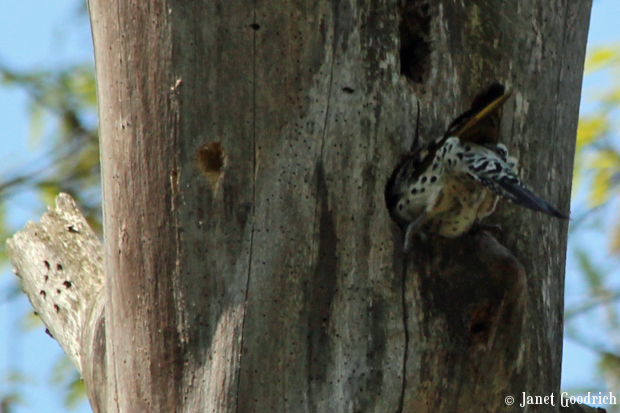
Flicker fanny... 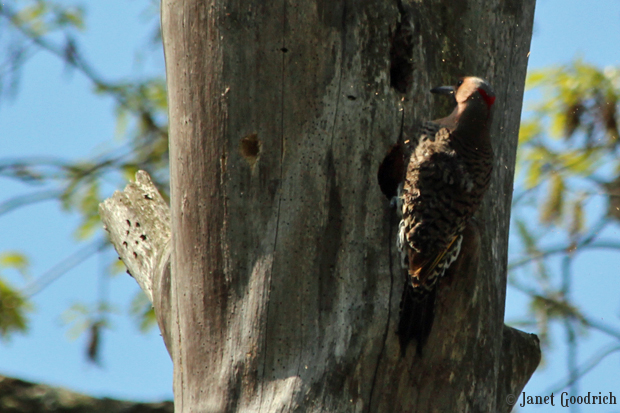
Flicker shaking off particles of sawdust before ducking inside for more excavating. I read that these birds are in decline. Starlings compete for their nesting sites and usually win. It made the knowledge of this nest all the more exciting. This is the fourth nest we’ve discovered: the robin in our front shrub, the pileated pair, a red-bellied woodpecker nest at another site, and now the flicker. There’s a feeling of privilege in being able to observe such things.
The day was so nice that we took another short stroll at a different place. We stumbled upon a buttercup carpet.
These are just a few of the sights and sounds we enjoyed. We also saw many yellow warblers, mockingbirds, catbirds, robins, chipping sparrows and song sparrows and tree swallows. Off in the woods, we heard a hermit thrush sing its rippling, echoing song. A Baltimore oriole flitted about in the treetops overhead, warbling conversationally.
Beauty everywhere. It was inspiring and quieting in the best ways.


